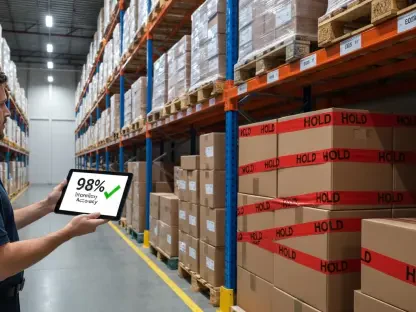Unraveling the Impact of Regulatory Shifts on Global Logistics
In the dynamic realm of global e-commerce, a staggering volume of parcels crosses U.S. borders daily, fueling a multi-billion-dollar industry that thrives on speed and efficiency. Yet, a monumental policy change has disrupted this flow: the elimination of the de minimis exemption, which once allowed shipments under $800 to enter the U.S. without duties or taxes. This seismic shift, enacted on August 29, has introduced unprecedented customs challenges, affecting major parcel carriers like UPS, FedEx, and DHL Express. This market analysis delves into how these logistics giants are navigating the new regulatory landscape, examines current trends in cross-border shipping, and projects future directions for the industry. The stakes are high as the peak holiday season looms, making it critical to understand the strategies shaping this evolving market.
Deep Dive into Market Trends and Carrier Responses
The Fallout of De Minimis Removal: A Market Disruption
The termination of the de minimis exemption has sent shockwaves through the cross-border shipping market, fundamentally altering cost structures and operational timelines. Previously, low-value shipments enjoyed a streamlined entry process, benefiting both foreign merchants and American consumers with reduced expenses and swift deliveries. Now, every parcel faces scrutiny from U.S. Customs and Border Protection (CBP), requiring detailed documentation such as Harmonized System (HS) commodity codes and country of origin data. Industry data indicates a sharp rise in customs delays, with many packages held beyond the standard 15-day clearance window, leading to returns or disposals. This disruption has not only increased operational costs for carriers but also strained their capacity to manage heightened volumes.
The ripple effects are evident across the supply chain, particularly for smaller shippers unprepared for stringent compliance demands. Market reports suggest that these delays are eroding consumer confidence, as delivery timelines stretch and unexpected costs emerge. For major carriers, the challenge lies in balancing regulatory adherence with maintaining service quality, a task that becomes even more daunting as seasonal demand surges. This trend underscores a broader market shift toward stricter import controls, prompting a reevaluation of logistics strategies.
Evolving Responsibilities and Consumer Impact
A notable trend in the current market is the redesignation of U.S. buyers as importers of record under the new customs rules. This shift places the burden of duty payments and clearance issues directly on consumers, creating friction in the purchasing process. Industry insights reveal growing dissatisfaction among buyers, with a significant portion abandoning orders or seeking refunds when faced with surprise fees. This dynamic poses a substantial risk to e-commerce businesses, especially during high-stakes periods like the holiday season, where customer loyalty is paramount.
For carriers like UPS, FedEx, and DHL Express, this trend complicates their role as intermediaries. While not directly liable for duties, they must manage the fallout of customer complaints and logistical bottlenecks. Market analysis points to a growing need for alternative solutions, such as shippers or third-party brokers assuming importer responsibilities to alleviate consumer burdens. This evolving responsibility landscape is reshaping market expectations, pushing stakeholders to prioritize transparency and proactive communication to sustain trust.
Carrier-Specific Strategies: A Competitive Analysis
Each major carrier has carved out distinct approaches to tackle customs challenges, reflecting varied priorities in a competitive market. UPS has implemented a structured response, reaching out to shippers for missing documentation and offering return options at the sender’s expense if issues persist, with disposal as a final measure. Market feedback indicates that UPS maintains a high clearance rate, with over 90% of packages processed on the first day, showcasing operational resilience despite regulatory hurdles.
FedEx, meanwhile, emphasizes collaboration with shippers to update paperwork, notifying recipients of clearance issues and providing return or disposal options for unresolved cases. In contrast, DHL Express stands out by avoiding disposal entirely, opting to return shipments to origin within a 10-day window if clearance fails. These differing policies highlight a fragmented market response, where carriers balance CBP compliance with customer-centric solutions. Regional variations, such as stricter enforcement at certain U.S. ports, further complicate the competitive landscape, driving carriers to tailor strategies to local conditions.
Emerging Technologies and Market Projections
Looking ahead, the cross-border shipping market is poised for transformation through technological innovation and regulatory adaptation. AI-driven tools for documentation accuracy and automated compliance checks are gaining traction, promising to reduce errors and expedite customs processes. Market projections suggest that by 2027, adoption of such technologies could cut clearance delays by a significant margin, offering a lifeline to carriers and shippers alike. Digital platforms that facilitate compliance for foreign merchants are also expected to see increased demand, reshaping operational models.
Regulatory landscapes may shift as well, with potential policy adjustments influencing market dynamics over the next few years. Analysts anticipate that economic factors, including rising tariffs, could further impact shipping costs, necessitating agile cost-management strategies. However, the trend toward partnerships between carriers, shippers, and customs brokers offers a positive outlook, fostering a collaborative environment to streamline operations. These innovations and projections signal a market in transition, adapting to post-de minimis realities with a focus on efficiency and compliance.
Reflections and Strategic Pathways Forward
Looking back, the elimination of the de minimis exemption marked a turning point for the cross-border shipping industry, challenging UPS, FedEx, and DHL Express to rethink their operational frameworks amidst customs delays and shifting responsibilities. The market analysis revealed a landscape fraught with disruption but also ripe with opportunity for those who adapt swiftly. Varied carrier strategies and emerging technological solutions point to a resilient industry response, even as consumer impacts underscore the urgency for change. Moving forward, shippers are encouraged to invest in accurate documentation practices and leverage third-party brokers to navigate compliance hurdles. Carriers, meanwhile, need to deepen investments in automation to stay competitive. Ultimately, fostering collaboration across the supply chain emerges as the cornerstone for turning regulatory challenges into sustainable growth, ensuring that the industry can thrive in an ever-evolving global trade environment.









